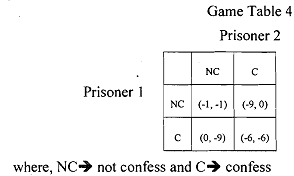NASH EQUILIBRIUM:
The purpose of tabular representation of a simultaneous move game is to predict the actual behaviour of the players and the resultant payoff when the game is played. We look for an equilibrium in which each player's action is the best response to the actions of the other players. The equilibrium concept we employ here is known as the Nash equilibrium. The concept is named after mathematician and economist and Nobel Prize winner John Nash. Nash described the equilibrium of a non-cooperative game as a configuration of strategies, one for each player such that each player's strategy is best for her given that all the other players are playing their equilibrium strategy.
Definition: In a 'n' player normal form game G={S1, S2,... Sn; U1, u2, ... un}, the strategies (s1*, s2*, ......., sn*,) constitute a Nash equilibrium if, for each player i, s, is player i's best response to the strategies specified for the (n-I) other

Nash equilibrium is strategically stable and self-enforcing because no single player wants to deviate from her predicted strategy.
Example: Game of Prisoners' Dilemma
This is a classic example in game theory. Two prisoners have two strategies available to them: confess and not confess. They are kept in two separate cells and the payoff to the player when a particular pair of strategy is chosen is given in the following payoff matrix. The negative numbers in each celI represent years of imprisonment. By convention the payoff to the row player is the first payoff given in each cell.

Note that irrespective of what prisoner 1 chooses, prisoner 2 will always choose 'C' to minimise her years of imprisonment. Similarly, prisoner1 will always choose 'C'. Therefore, (C, C) is the Nash equilibrium of the game (though it seems that (NC, NC) is the likely equilibrium, but it is not Nash equilibrium).
In the above example, there was a unique Nash equilibrium of the game. But there may be cases in which there are multiple Nash equilibria in a single game. Let us illustrate with the famous game of battle of sexes.